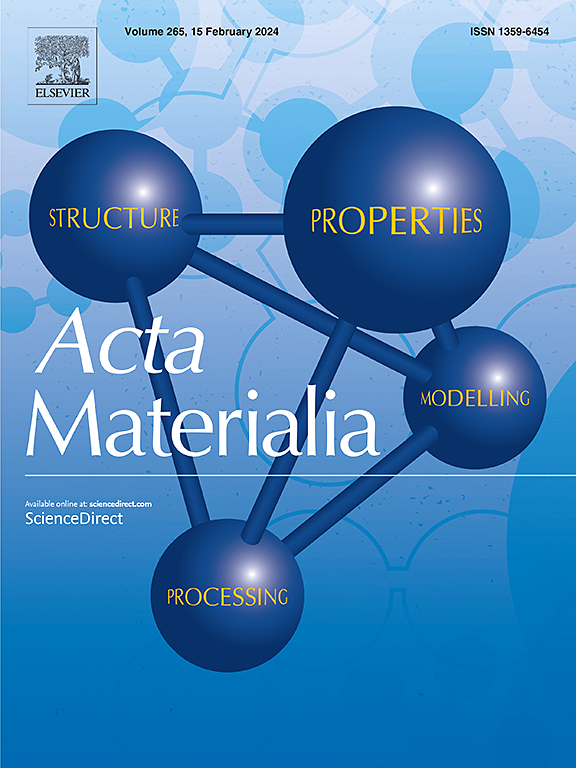铝中空穴成核和聚结前驱物的定量分析
IF 9.3
1区 材料科学
Q1 MATERIALS SCIENCE, MULTIDISCIPLINARY
引用次数: 0
摘要
延性断裂是工程合金常见的破坏模式。它一般由三种机制组成:次级颗粒处的孔洞成核、孔洞的生长和孔洞的合并。传统的韧性断裂模型在预测宏观破坏方面精度有限。这部分是因为它们已经通过对这三种机制的非原位观察和宏观应变或应力指标进行校准得到了证实。在这项研究中,进行了原位高能x射线表征,通过颗粒开裂将空洞成核的位置与晶粒尺度尺度的空洞生长位置联系起来。本文表明,颗粒开裂不是由升高的应力指标来预测的,这与经典模型不一致。相反,颗粒裂纹往往发生在最大,最小的球形颗粒。这种趋势在总体尺度上和粒子周围的单个邻域内持续存在。此外,Eshelby分析表明,与未破裂的颗粒相比,裂纹颗粒内的最大主应力在统计上显着增加。现场观察还揭示了两个独立的晶内空洞生长的例子,包括扁平的、裂纹状的特征,它们的生长显示出与最高剪切应力的滑移系统一致。尸检断口分析显示,在这些类裂纹特征上有二次凹陷,这意味着在这种类裂纹空洞生长过程中可能发生了空洞层。这些原位观察表明,假设介质为均匀介质的经典孔洞生长模型应该扩展到考虑各向异性的晶粒级行为,以正确捕捉孔洞成核和生长的明显特征。本文章由计算机程序翻译,如有差异,请以英文原文为准。

Quantifying precursors to void nucleation and coalescence in aluminum
Ductile rupture is a common failure mode for engineering alloys. It is generally comprised of three mechanisms: void nucleation at secondary particles, void growth, and coalescence of voids. Conventional models for ductile rupture have limited precision for predicting macroscopic failure. This is partially because they have been corroborated using ex-situ observations of these three mechanisms and calibrated by macroscopic strain or stress metrics. In this study, in-situ high-energy X-ray characterization was conducted to correlate sites of void nucleation via particle cracking and sites of void growth with grain-scale metrics. Here it is shown that particle cracking is not predicated by elevated stress metrics, which disagrees with classical models. Instead, particle cracking tended to occur for the largest, least spherical particles. This trend persisted on the aggregate-scale and within individual neighborhoods around particles. Furthermore, an Eshelby analysis illuminated a statistically significant increase in maximum principal stress within a cracked particle, compared to an uncracked particle. In-situ observations also revealed two separate examples of intragranular void growth comprised of flat, crack-like features that grew showing alignment with slip systems of the highest resolved shear stress. Post-mortem fractography revealed a secondary population of dimples on these crack-like features, implying that void sheeting may be occurring during this crack-like void growth. These in-situ observations imply that classical models for void growth, that assume a homogenous medium, should be extended to account for the anisotropic grain-level behavior to correctly capture distinct features of void nucleation and growth.
求助全文
通过发布文献求助,成功后即可免费获取论文全文。
去求助
来源期刊

Acta Materialia
工程技术-材料科学:综合
CiteScore
16.10
自引率
8.50%
发文量
801
审稿时长
53 days
期刊介绍:
Acta Materialia serves as a platform for publishing full-length, original papers and commissioned overviews that contribute to a profound understanding of the correlation between the processing, structure, and properties of inorganic materials. The journal seeks papers with high impact potential or those that significantly propel the field forward. The scope includes the atomic and molecular arrangements, chemical and electronic structures, and microstructure of materials, focusing on their mechanical or functional behavior across all length scales, including nanostructures.
 求助内容:
求助内容: 应助结果提醒方式:
应助结果提醒方式:


